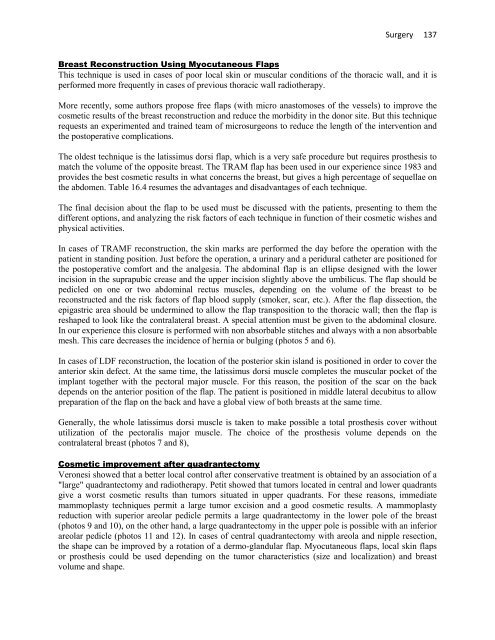Breast Cancer - Arab Medical Association Against Cancer
Breast Cancer - Arab Medical Association Against Cancer
Breast Cancer - Arab Medical Association Against Cancer
- No tags were found...
You also want an ePaper? Increase the reach of your titles
YUMPU automatically turns print PDFs into web optimized ePapers that Google loves.
Surgery 137<strong>Breast</strong> Reconstruction Using Myocutaneous FlapsThis technique is used in cases of poor local skin or muscular conditions of the thoracic wall, and it isperformed more frequently in cases of previous thoracic wall radiotherapy.More recently, some authors propose free flaps (with micro anastomoses of the vessels) to improve thecosmetic results of the breast reconstruction and reduce the morbidity in the donor site. But this techniquerequests an experimented and trained team of microsurgeons to reduce the length of the intervention andthe postoperative complications.The oldest technique is the latissimus dorsi flap, which is a very safe procedure but requires prosthesis tomatch the volume of the opposite breast. The TRAM flap has been used in our experience since 1983 andprovides the best cosmetic results in what concerns the breast, but gives a high percentage of sequellae onthe abdomen. Table 16.4 resumes the advantages and disadvantages of each technique.The final decision about the flap to be used must be discussed with the patients, presenting to them thedifferent options, and analyzing the risk factors of each technique in function of their cosmetic wishes andphysical activities.In cases of TRAMF reconstruction, the skin marks are performed the day before the operation with thepatient in standing position. Just before the operation, a urinary and a peridural catheter are positioned forthe postoperative comfort and the analgesia. The abdominal flap is an ellipse designed with the lowerincision in the suprapubic crease and the upper incision slightly above the umbilicus. The flap should bepedicled on one or two abdominal rectus muscles, depending on the volume of the breast to bereconstructed and the risk factors of flap blood supply (smoker, scar, etc.). After the flap dissection, theepigastric area should be undermined to allow the flap transposition to the thoracic wall; then the flap isreshaped to look like the contralateral breast. A special attention must be given to the abdominal closure.In our experience this closure is performed with non absorbable stitches and always with a non absorbablemesh. This care decreases the incidence of hernia or bulging (photos 5 and 6).In cases of LDF reconstruction, the location of the posterior skin island is positioned in order to cover theanterior skin defect. At the same time, the latissimus dorsi muscle completes the muscular pocket of theimplant together with the pectoral major muscle. For this reason, the position of the scar on the backdepends on the anterior position of the flap. The patient is positioned in middle lateral decubitus to allowpreparation of the flap on the back and have a global view of both breasts at the same time.Generally, the whole latissimus dorsi muscle is taken to make possible a total prosthesis cover withoututilization of the pectoralis major muscle. The choice of the prosthesis volume depends on thecontralateral breast (photos 7 and 8),Cosmetic improvement after quadrantectomyVeronesi showed that a better local control after conservative treatment is obtained by an association of a"large" quadrantectomy and radiotherapy. Petit showed that tumors located in central and lower quadrantsgive a worst cosmetic results than tumors situated in upper quadrants. For these reasons, immediatemammoplasty techniques permit a large tumor excision and a good cosmetic results. A mammoplastyreduction with superior areolar pedicle permits a large quadrantectomy in the lower pole of the breast(photos 9 and 10), on the other hand, a large quadrantectomy in the upper pole is possible with an inferiorareolar pedicle (photos 11 and 12). In cases of central quadrantectomy with areola and nipple resection,the shape can be improved by a rotation of a dermo-glandular flap. Myocutaneous flaps, local skin flapsor prosthesis could be used depending on the tumor characteristics (size and localization) and breastvolume and shape.









